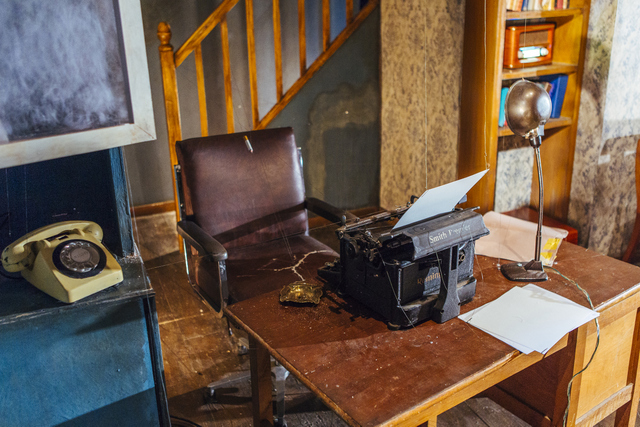Editor’s Note: This article was written about a preview performance of Beckett’s Room. However, theatre conventions dictate that a preview performance represents a theatrical presentation that precedes a show’s official opening, rather than a completed show, and should not be subject to review by theatre critics. An editing error meant that the fact that it was a preview was initially not mentioned, but the senior editorial staff of The University Times would like to acknowledge our error in publishing a review of this performance, and to extend our apologies to those involved in the production.
The Dead Centre’s preview production of Beckett’s Room represented an experiment in staging “a play without performers”, but ultimately it highlighted their importance in live storytelling.
Although meticulously choreographed, the production’s reliance on puppetry and audiovisual technology failed to compensate for the lack of bodies onstage. The attempt simulated the sensation of running alongside a departing Luas: just because you’re sweating doesn’t mean it’s going to work out in the end.
Having taken our seats in the Gate Theatre, we were each invited to don a pair of high-quality headphones. This seemed thrillingly rebellious in a theatre with such a rich repertoire of traditional adaptations, but the excitement was short-lived. It rapidly came to light that the three rows to my rear were without sound. You could almost hear an older generation of Beckett fanatics sigh as they fumbled to silence their Nokias.
So, as a menacing projection of a closed, twitching eyelid played on a large onstage screen, the majority of us were forced to listen to typewriter sounds on loop until the Gate staff relocated the unfortunate patrons accordingly. The suspension of my disbelief had hit its first obstacle – and the house lights were still up.
Once the show began and the dystopian video sequence ceased, I was dismayed to see the thick gauze screen still standing erect between myself and the onstage action. So much for the limitations of the proscenium stage, this screen created a literal, tangible fourth wall.
As voices began to converse in French, given the room’s Parisian setting, I was perturbed further by the appearance of wide subtitles on the gauze. Just when I became absorbed in the drama, sliding italic letters would obstruct the stage picture to remind me where I was – in a bizarre, haunted Beckettian foreign film.
However, there’s no hiding my admiration for the depth of thought, tenacity and bravery of Dead Centre’s mission. In true Beckettian spirit they pushed the boundaries of the form and notions of minimalism further than I had thought, and perhaps still think, plausible.
The manipulation of sound in this production was also rather astonishing. Without visual prompts, one could trace audio footsteps floorboard by floorboard as they seemed to transition from your left to right ear effortlessly. In moments such as these, I saw a vignette of the technical theatre of tomorrow and it looked promising.
Praise must also be handed to the minds and fingers behind the practical staging of this piece. While telephones occasionally hung in the air long after the click of the receiver was heard and cigars were sometimes smoked by a seated ghost with a mouth where his hairline should be, the course of action never for a moment lost its comprehensibility.
The busy fingers working in the shadows, particularly in the climactic crescendo in the second act, seemed to be co-operating in their droves. However, when just four performers, Ciarán Bonner, Justine Cooper, Eugenia Genunchi and Jason Lambert, appeared to take a final bow, the sheer magnitude of this company’s achievement hit the auditorium like a wave. Imperfect and perhaps over-ambitious though it was, directors Ben Kidd and Bush Moukarzel had certainly aimed for the moon.
However, a disturbing moment occurred in the final act, upon Samuel Beckett and his lover Suzanne Dechevaux-Dumensil’s return to the apartment in 1945. Guests arrived bearing the impressive gift of a live bird in the midst of food rations. However, while both the residential and visiting couples in the scene were physically absent, a live cock was shoved on stage between their pseudo-footsteps.
Though initially greeted with a measly scattering of chicken feed, the bird soon registered his solitude, and his proximity to glaring lights and moving shadows. Having got his feet ensnared in invisible puppet-string, the bird began to panic. The bird’s audible groans of distress, though buffered by a screen and padded earphones, dominated the entire scene.
Suddenly, I was catapulted back to circuses and amphitheaters of yore, where animals were thrown into rings to face the non-contractual perils man refused to. In 2019, in Dublin’s Gate Theatre, is this a reference today’s theatre-makers pride themselves on communicating? Moreover, is the territory of reviving Beckett’s personal narrative too daunting for man, but not too daunting for a beast? A production I respected conceptually until this point suddenly plummeted in my estimations.
Admittedly, I resonated most with the bird in this piece – perhaps my innate narcissism was attracted to compatible liveness. At first, the concept presented this production as a promising pursuit. However, once these initial flaggings dissipated, the uglier, impractical realities of the piece captured my attention. And due to the layered obstructions separating myself and the epicentre of the piece, my disbelief, short of being suspended, never even got a disciplinary notice. In short, this production may get almost full marks in theory, but considerably less in practice.






